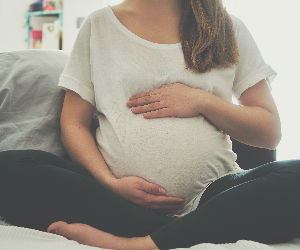
Most expectant parents know what they want come delivery day. In their birth plans, they’ve detailed everything, from their birth team to their choice of pain medications to the atmosphere in the room.
But childbirth rarely goes as planned.
While we advocate for a safe delivery with your health care provider at your side, there will always be cases when baby arrives before professional help does. In these situations, when a car or home delivery is necessary, parents-to-be should keep an emergency birth kit on-hand.
The first thing to remember is to stay calm. Even if you can’t get to the hospital you can still get help—call 911 and, while you await an ambulance, a qualified healthcare professional can advise you on your next steps. Next, grab your emergency delivery kit.
Must-haves for your emergency birth kit
1. A bag of large under pads with plastic backing (to place under mom)
2. Box of disposable plastic or latex gloves
3. Baby size bulb syringe (to clear baby’s airway if needed)
4. Towels and blankets (to dry and keep baby warm)
5. Two white shoe laces (to tie umbilical cord)
6. Sharp scissors (to cut umbilical cord)
7. A large bowl (to deliver the placenta)
8. Twelve large sanitary pads (for mom after delivery)
9. Chemical cold pack (to soothe mom after delivery)
10. Small bottle of isopropyl alcohol
11. A package of large cotton balls (to clean off the umbilical cord with isopropyl alcohol if you need to
change the baby’s diaper)
11. Six disposable diapers
12. Pain pills such as Tylenol or Advil
13. Small bar of antibacterial soap
Tips to survive an emergency birth
If you find yourself facing a surprise home birth, sterilize your scissors and shoelaces by submerging them in boiling water for 20 minutes. Then, pour off the water but do not touch the items until needed. If you are not able to boil water, wash your equipment with soap and water and soak them in alcohol during labor.
After delivery, place the baby on mom’s bare chest and stomach for skin-to-skin contact. Not only does skin-to-skin contact promote bonding, but it also keeps baby warm, and helps to regulate his or her heart, respiratory, and oxygen saturation rates.
Also remember that early breastfeeding is greatly beneficial to both mom and baby, stopping bleeding, clearing mucus from baby’s mouth and nose, and providing baby with milk that contains disease-fighting antibodies.
Fortunately, babies are not often born in this kind of emergency setting. Typically, moms know when the time is coming near—either because of leaking fluid or strong contractions—and they can make it to the hospital in time for delivery. But in the 1 percent of cases where there just isn’t time, this kit can help get you through labor and ensure baby is safely brought into the world.
— Dr. Nita Landry, known as “Dr. Nita,” is a co-host on the Emmy® Award-winning talk show The Doctors and a board- certified OB/GYN.


We several questions: What is the purpose of 12 pads and 6 diapers? How far away from the hospital are you? What happens when you have gray shoestrings instead of white? What is the evidence behind using isopropyl alcohol on the umbilical cord? Where is the Vitamin K injection? Is this winter or summer, do we need a hat? What background noises do you recommend? What kind of gas do you need in the car? Should we bring extra gas? Are flares necessary for celebration?
Hi there,
Thank you for reading and for sharing your thoughts with us. Please note that Dr. Nita’s emergency kit is only meant to hold new parents over until an ambulance arrives (see the above note to call 911), at which point a proper evaluation, including initial vaccines, will be administered. As for the celebratory flares, we think you might be a bit too preoccupied for those 🙂
We reached out to Dr. Nita with a few of your questions. Here’s what she had to say:
What is the purpose of 12 pads and 6 diapers? Twelve pads for mom after delivery (for vaginal bleeding) and 6 diapers for baby. For emergency home births, (in most instances) this should get you by until you get to a hospital. However, please feel free to buy more.
What happens when you have gray shoestrings instead of white? No problem. Use what you have.
What is the evidence behind using isopropyl alcohol on the umbilical cord? Isopropyl alcohol is readily available, so it’s a convenient choice that you can use to keep things clean during the immediate hustle and bustle of a home delivery. (Remember, these instructions are only to get you by in an emergency situation…until help arrives) However, when thinking about ongoing care of the umbilical stump, you will simply clean it with plain water.